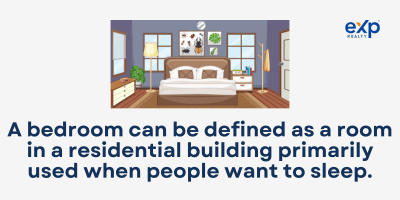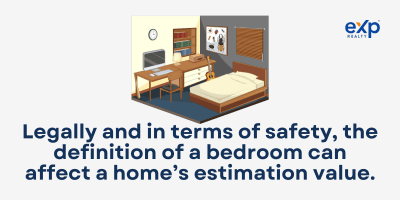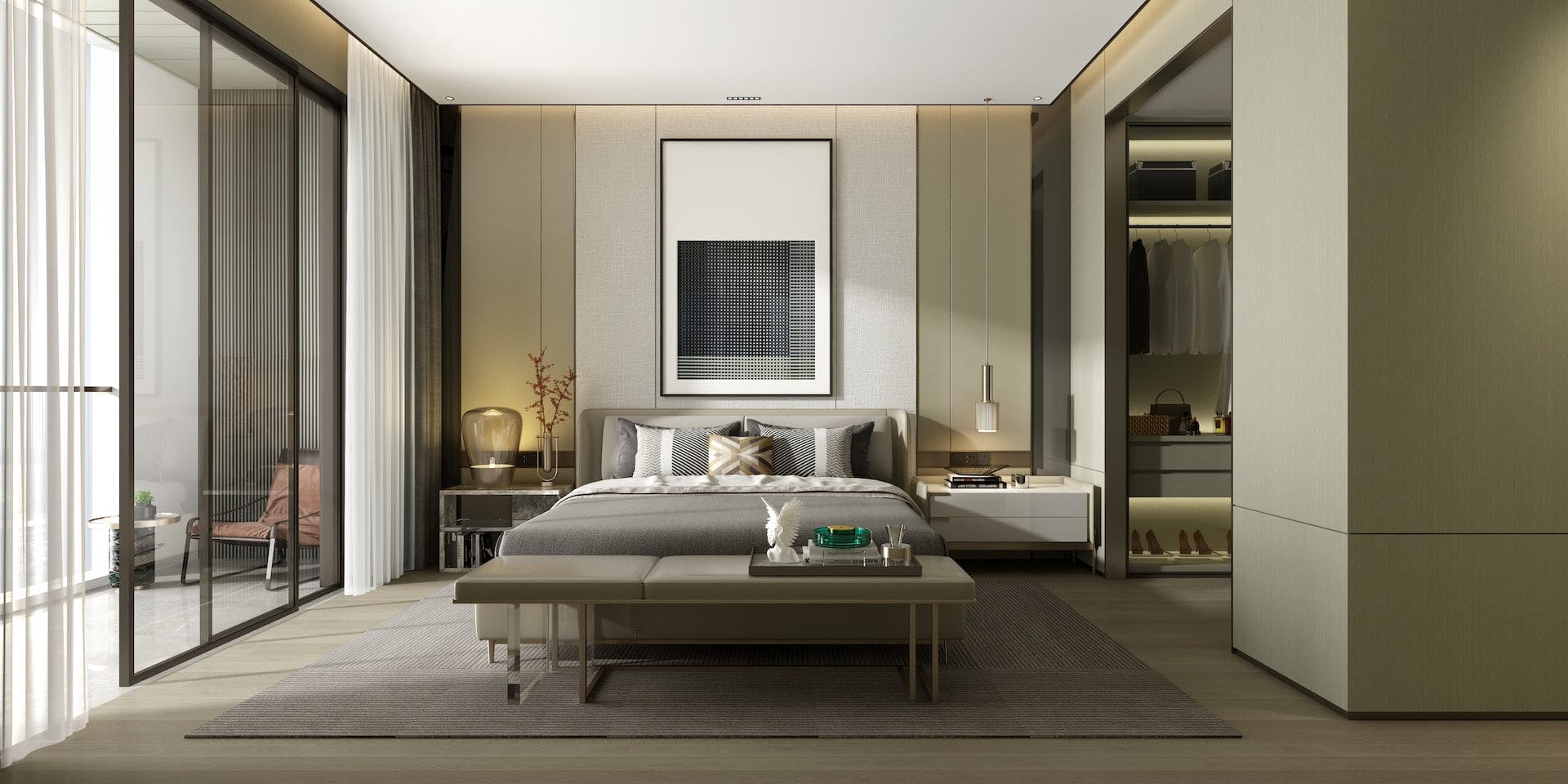Have you ever wondered what exactly constitutes a bedroom? Is it simply just a room that has a bed in it? Well, not quite. While it may seem like there are no rules or guidelines to what makes a room a bedroom, a few key components actually make it so.
From the number of windows to the required square footage, understanding the definition of a bedroom can be a helpful tool when buying or selling a home. So, let’s dive into the details and learn more about what exactly makes a room a true bedroom.
What Makes a Room a Bedroom?
A bedroom can be defined as a room in a residential building primarily used when people want to sleep. It is specifically designed so that occupants feel comfortable and have some privacy.
Once you walk into a bedroom, you will find bedroom furniture, at least one bed, a dresser on the side, and a storage space primarily for clothes, like a built-in closet or a clothes closet. You can also find lamps, desks and chairs there.
The bedroom occupants also need the means to access it, such as a door and safe exit in an emergency for safety reasons. However, bedrooms vary in terms of jurisdiction and building codes. To be considered a room, it should meet specific minimum requirements.
Bedroom Minimum Requirements
Although the minimum size requirements differ due to building code requirements, the average ranges from 70 to 80 square feet. Different jurisdictions may set additional requirements according to the type of house and occupancy levels.
Secondly, the average minimum height requirement for a bedroom is 7 feet. The condition is set so the occupants can have adequate space to move around and not feel claustrophobic.
A room can’t be considered a bedroom without any form of egress, like a window that can be accessed during an emergency. The opening should be big enough for a person to pass through and be located near the floor. Jurisdictions also state that these windows should have a specific width and height.
They are also specific minimum requirements for a closet so that the room can be functional and be used as a living space. Although cabinets aren’t necessarily just found in a typical bedroom, they are still needed to store clothes and other personal belongings.
Additional Requirements
Apart from the above requirements, the others include access to a bathroom (either a master bathroom or a regular one), natural light, and the number of doors leading to the room. Various jurisdictions can set additional requirements, like the minimum number of electrical outlets and specific insulation levels.
Understanding the definition of a bedroom is essential when buying and selling a house, as it determines the property’s value. A home with more bedrooms has more weight than those with lower ones. In addition, to be called a bedroom, the room should fulfill the minimum requirements set by the jurisdiction. This can affect the value and usability of the property.
Why Does the Definition of a Bedroom Matter?

Knowing the definition of a bedroom is one of the legal and safety measures that affect a house’s buying and selling process. You must know these measures as a buyer, seller, homeowner, and insurance company.
Legally and in terms of safety, the definition of a bedroom can affect a home’s estimation value, similarly affecting the amount of money available to buyers. A room considered a bedroom but does not meet the minimum requirements for size, minimum ceiling height, methods of egress, and storage, can be a safety risk.
Occupants should be able to exit a room safely when a fire occurs. Homeowners may face legal issues if they misrepresent a room as a bedroom.
Bedrooms in Appraisals
Regarding appraisal and lenders, the definition of a bedroom may affect the estimated value of a house. Appraisers note the number of bedrooms in the property before estimating its value, while lenders may look at the minimum number of bedrooms required for a mortgage.
Buyers should accurately represent the number of bedrooms to avoid financing and appraisal issues.
Legalities About Bedrooms
Buyers and homeowners need to understand the definition of a bedroom before buying or selling a home. Buyers usually look for a specific number of bedrooms and can only be satisfied if a room named a bedroom meets the legal bedroom requirements and bedroom definitions.
It is a requirement for homeowners to give out the legal status of each room to anyone willing to buy the house. If they don’t do that, they will face legal issues.
Last but not least, home insurance coverage and rates are affected by the definition of a bedroom space. The room must meet building safety codes before the insurance company agrees to cover it. The number of bedrooms in the room also affects the insurance costs.
In conclusion, not understanding the definition of a bedroom can lead to confusion and disappointment for both buyers and sellers. Buyers and homeowners should accurately list the number of bedrooms and ensure all the rooms meet the minimum bedroom requirements.
Common Misconceptions About Bedrooms
There are many misconceptions that people have when it comes to a bedroom. Some of these are:
1. Any Room With a Bed in It Can Be Considered a Bedroom
People usually think this, but for a room to be considered a bedroom, it should meet specific requirements like size, ceiling height, minimum height, minimum opening height, egress (like an egress window or other operable emergency escape), and storage requirements.
2. The Number of Bedrooms Listed in a Home’s Description Is Always Accurate
Real estate agents and homeowners are legally required to be honest about the number of bedrooms in a house, but this is usually not the case. It is also important to recognize between a bonus room and an actual bedroom.
3. A Room With a Closet Is Automatically Considered a Bedroom
A cabinet is one requirement for a space to be termed a bedroom. However, it isn’t the only requirement. Other conditions should be satisfied, like size and egress requirements.
4. A Basement or Attic Room Can Always Be Used as a Bedroom
Basement and attic rooms are usually made into basement and attic bedrooms, but specific requirements need to be met, especially egress requirements. The bedroom should have a large window for a person to pass through in an emergency.
5. It’s Easy To Convert a Non-Conforming Room Into a Legal Bedroom
It isn’t easy to convert a non-conforming room into a legal bedroom. It can be rather complicated and expensive if the room may meet the legal requirements of a bedroom. For example, if the room doesn’t meet the egress requirements, adding a window may require expensive renovations or permits from local authorities.
6. A Bedroom Must Have a Door
A bedroom doesn’t necessarily need to have a door if it meets the other legal requirements for a bedroom. A door is usually preferred for privacy and safety.
Key Takeaways

Understanding the definition of bedroom before buying or selling a house is essential. For a room to be considered a bedroom, it should meet specific legal requirements such as minimum size, ceiling height, and storage requirements. Misrepresenting a bedroom can bring legal issues, safety hazards, and financial issues.
Buyers should ensure that the number of bedrooms provided in a property’s description is accurate and that every room listed as a bedroom meets the legal requirements. All requirements must be factored in. Nothing should be left out. In conclusion, whether buying or selling a house, you need to fully grasp the legal definition of bedroom.
If you need further information on the definition of a bedroom and other related queries, you can contact a real estate professional. They will guide you through the whole process of buying and selling a house and make informed decisions.
For everything from 2-bedroom houses to 6+ bedroom houses, check out our listings to find your perfect new home. Furthermore, you can sign up to get alerts of new property/house/condo/etc listings when they come on the market.
FAQs: Definition of Bedroom
What is the purpose of a bedroom?
The primary purpose of a bedroom is to provide occupants with a private space to sleep and rest. There, they can retreat for privacy, relaxation, and rejuvenation.
What is in a bedroom?
The furniture in a bedroom consists of a bed, a dresser by the bedside, and a closet for clothing. Additionally, occupants may have desks, chairs, and additional seating like couches.
What is a bedroom in architecture?
In architectural terms, the definition of a bedroom is a private room in a house mostly used for sleeping. It is situated away from all other public spaces for privacy reasons.
What are the characteristics of a bedroom?
A bedroom is usually characterized by a bed for sleeping, a door for privacy, and a window to let in natural air and light. Other features are desks, chairs, and storage spaces.
What is the legal definition of a bedroom?
The legal definition of the bedroom differs from one jurisdiction to another. Primarily, the legal definition is determined by the minimum requirements of a bedroom. The requirements include minimum size requirements, minimum ceiling requirements, emergency egress requirements, and closet requirements.
Can a bedroom have no closet?
Yes, a bedroom can’t have a closet and still be considered one.
Can a bedroom have no windows?
Jurisdictions require bedrooms to have some type of method of egress, like a window that lets in natural light. However, this doesn’t apply to basement bedrooms.
Can a bonus room be considered a bedroom?
A bonus room can only be termed as a bedroom if it meets the minimum requirements for a bedroom.
Can a closet be a bedroom?
A bedroom is usually private and used for sleeping. Additionally, the room must have a bed. So no, a closet can’t be a bedroom.
What are the four things a room must have to be considered as a bedroom?
The four things a room must have to be considered a bedroom differ from one jurisdiction to another, but generally, these are a window for egress, a door for privacy, a bed for sleeping, and the minimum size requirements. Additional characteristics include minimum ceiling and storage requirements.





